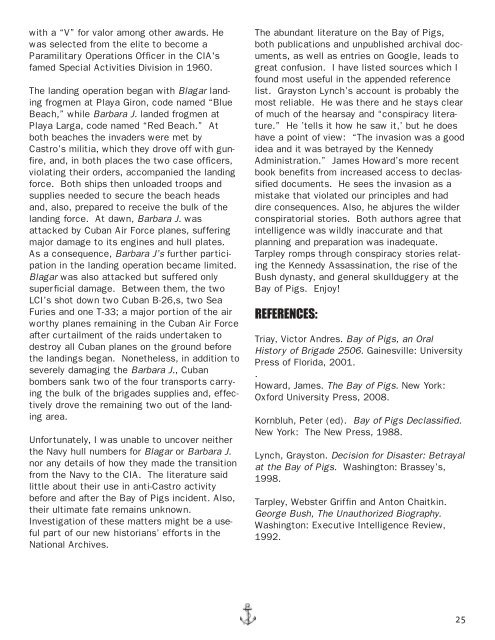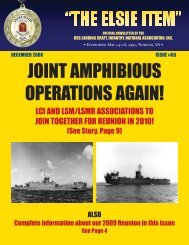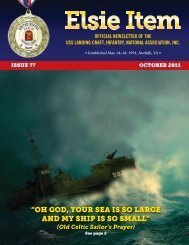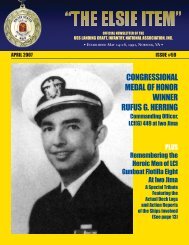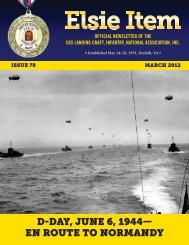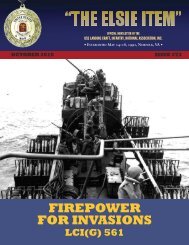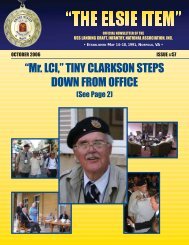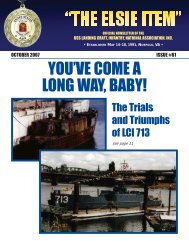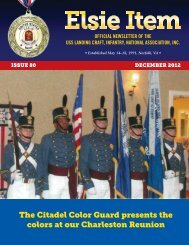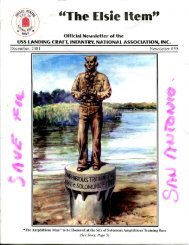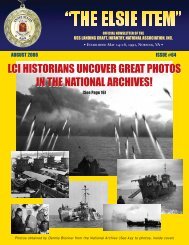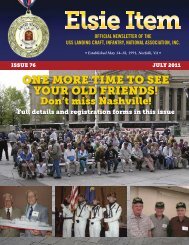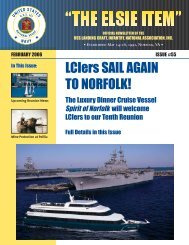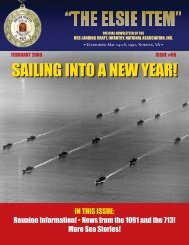elsie item issue 67 - USS Landing Craft Infantry National Association
elsie item issue 67 - USS Landing Craft Infantry National Association
elsie item issue 67 - USS Landing Craft Infantry National Association
- No tags were found...
You also want an ePaper? Increase the reach of your titles
YUMPU automatically turns print PDFs into web optimized ePapers that Google loves.
with a “V” for valor among other awards. Hewas selected from the elite to become aParamilitary Operations Officer in the CIA'sfamed Special Activities Division in 1960.The landing operation began with Blagar landingfrogmen at Playa Giron, code named “BlueBeach,” while Barbara J. landed frogmen atPlaya Larga, code named “Red Beach.” Atboth beaches the invaders were met byCastro’s militia, which they drove off with gunfire,and, in both places the two case officers,violating their orders, accompanied the landingforce. Both ships then unloaded troops andsupplies needed to secure the beach headsand, also, prepared to receive the bulk of thelanding force. At dawn, Barbara J. wasattacked by Cuban Air Force planes, sufferingmajor damage to its engines and hull plates.As a consequence, Barbara J’s further participationin the landing operation became limited.Blagar was also attacked but suffered onlysuperficial damage. Between them, the twoLCI’s shot down two Cuban B-26,s, two SeaFuries and one T-33; a major portion of the airworthy planes remaining in the Cuban Air Forceafter curtailment of the raids undertaken todestroy all Cuban planes on the ground beforethe landings began. Nonetheless, in addition toseverely damaging the Barbara J., Cubanbombers sank two of the four transports carryingthe bulk of the brigades supplies and, effectivelydrove the remaining two out of the landingarea.Unfortunately, I was unable to uncover neitherthe Navy hull numbers for Blagar or Barbara J.nor any details of how they made the transitionfrom the Navy to the CIA. The literature saidlittle about their use in anti-Castro activitybefore and after the Bay of Pigs incident. Also,their ultimate fate remains unknown.Investigation of these matters might be a usefulpart of our new historians’ efforts in the<strong>National</strong> Archives.The abundant literature on the Bay of Pigs,both publications and unpublished archival documents,as well as entries on Google, leads togreat confusion. I have listed sources which Ifound most useful in the appended referencelist. Grayston Lynch’s account is probably themost reliable. He was there and he stays clearof much of the hearsay and “conspiracy literature.”He ’tells it how he saw it,’ but he doeshave a point of view: “The invasion was a goodidea and it was betrayed by the KennedyAdministration.” James Howard’s more recentbook benefits from increased access to declassifieddocuments. He sees the invasion as amistake that violated our principles and haddire consequences. Also, he abjures the wilderconspiratorial stories. Both authors agree thatintelligence was wildly inaccurate and thatplanning and preparation was inadequate.Tarpley romps through conspiracy stories relatingthe Kennedy Assassination, the rise of theBush dynasty, and general skullduggery at theBay of Pigs. Enjoy!REFERENCES:Triay, Victor Andres. Bay of Pigs, an OralHistory of Brigade 2506. Gainesville: UniversityPress of Florida, 2001..Howard, James. The Bay of Pigs. New York:Oxford University Press, 2008.Kornbluh, Peter (ed). Bay of Pigs Declassified.New York: The New Press, 1988.Lynch, Grayston. Decision for Disaster: Betrayalat the Bay of Pigs. Washington: Brassey’s,1998.Tarpley, Webster Griffin and Anton Chaitkin.George Bush, The Unauthorized Biography.Washington: Executive Intelligence Review,1992.25


